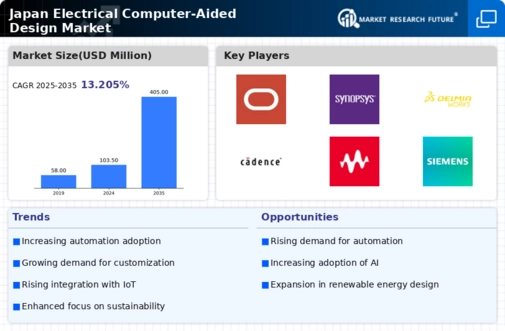Government Initiatives and Support
Government initiatives in Japan aimed at promoting technological innovation play a pivotal role in the electrical computer-aided-design market. Policies that encourage research and development in electrical engineering and design are fostering a conducive environment for market growth. For example, the Japanese government has allocated substantial funding for projects that enhance the capabilities of electrical design tools. This support is likely to stimulate advancements in software and hardware, thereby attracting more businesses to invest in the electrical computer-aided-design market. Furthermore, initiatives aimed at improving educational programs in engineering are expected to create a skilled workforce, which will further drive demand for sophisticated design solutions. Overall, these government efforts are anticipated to bolster the market's expansion in the coming years.
Increased Focus on Energy Efficiency
The growing emphasis on energy efficiency in Japan significantly impacts the electrical computer-aided-design market. As industries strive to reduce energy consumption and comply with stringent regulations, the demand for design tools that facilitate energy-efficient solutions is on the rise. This trend is particularly evident in sectors such as construction and manufacturing, where energy-efficient electrical systems are becoming a standard requirement. The market is projected to witness a growth rate of approximately 6% as companies seek to optimize their designs for energy savings. Additionally, the integration of renewable energy sources into electrical systems necessitates advanced design capabilities, further driving the need for innovative solutions in the electrical computer-aided-design market. This focus on sustainability is likely to shape the future landscape of the market.
Rising Demand for Smart Technologies
The increasing demand for smart technologies in Japan significantly influences the electrical computer-aided-design market. As industries such as automotive, consumer electronics, and renewable energy embrace smart solutions, the need for advanced design tools becomes critical. For instance, the automotive sector is integrating electric and autonomous vehicles, which require intricate electrical designs. This shift is expected to contribute to a market growth rate of around 7% annually. Additionally, the push for smart grids and IoT devices necessitates innovative design approaches, further driving the demand for electrical computer-aided-design solutions. Consequently, companies are investing in advanced software to meet these evolving requirements, indicating a robust growth trajectory for the electrical computer-aided-design market.
Technological Advancements in Design Software
The electrical computer-aided-design market in Japan is experiencing a surge. This surge is due to rapid technological advancements in design software. Innovations such as enhanced simulation capabilities and improved user interfaces are making it easier for engineers and designers to create complex electrical systems. The integration of advanced algorithms and real-time data processing is streamlining workflows, thereby increasing productivity. As of 2025, the market is projected to grow at a CAGR of approximately 8.5%, driven by these technological improvements. Furthermore, the adoption of 3D modeling and visualization tools is becoming more prevalent, allowing for better design accuracy and efficiency. This trend indicates a strong demand for sophisticated design tools that can handle the complexities of modern electrical systems, thereby propelling the electrical computer-aided-design market forward.
Collaboration and Partnerships in the Industry
Collaboration and partnerships among companies in Japan emerge as a key driver for the electrical computer-aided-design market. As firms seek to enhance their product offerings and expand their market reach, strategic alliances are becoming increasingly common. These collaborations often involve sharing resources, technology, and expertise, which can lead to the development of more advanced design tools. For instance, partnerships between software developers and hardware manufacturers are enabling the creation of integrated solutions that cater to the specific needs of the electrical design sector. This trend is expected to contribute to a market growth rate of around 5.5%, as companies leverage these partnerships to innovate and stay competitive. The collaborative approach is likely to foster a dynamic environment within the electrical computer-aided-design market, driving further advancements and opportunities.





















Leave a Comment